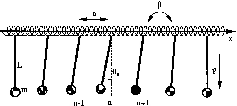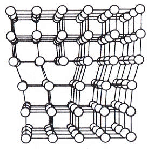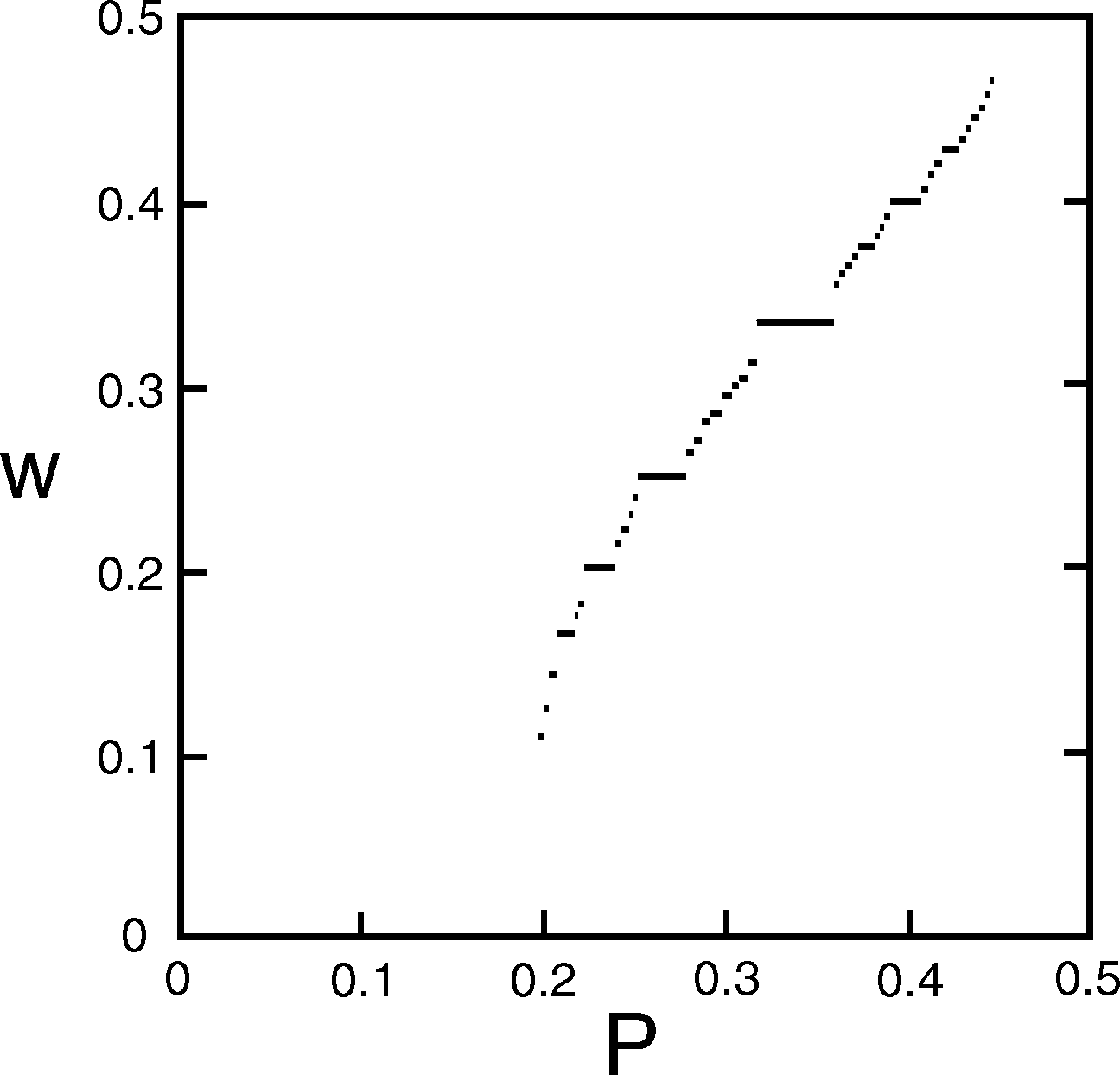Yakov Il'ich Frenkel & Tatyana Kontorova (1938)

one-dimensional
classical mechanics
harmonic nearest-neighboring (NN) springs
sinusoidal substrate potential
System of units: m = 1, a = 2π, εs= 2
Parameters: (i) g (elastic constant) and (ii) aA (lattice constant)
Limiting cases: g >> 1 or g ~ 1 or g << 1
Also important: aA= 2π or aA≠ 2π
Boundary conditions are also important. Variants:
free end(s) or
fixed density (in computer simulation
–
periodic b.c.)
Mathematics
integrable equations (sine-Gordon equation → topological and dynamical solitons)
Østochastic theory (standard map: GS → Aubry (C/IC) transition; metastable excitations → glass-like behavior)
Physics – richness and complexity of the phenomena involved
nonlinear interaction laws
competing lengths → incommensurability effects
possible disorder due to pinning effects and intricacy of the excitation spectrum
Applications - everywhere where one may separate a subsystem, and treat the remainder as an external substrate potential, damping, and thermal bath; in particular:
dislocations; domain walls in ferroelectrics, ferro- and antiferro-magnetics
crowdions in solids; super-ionic conductors
proton transport in biological molecules and ice-like crystals
ladder of Josephson junctions
amorphous solids
submonolayers adsorbed on crystal surfaces (including such questions as phase diagram of the system, surface reconstruction, surface diffusion, crystal growth)
tribology
|
Mechanical model |
Dislocation |
 |
 |
Adsorption on “furrowed” (metal) surfaces [fcc(110), bcc(112), hcp(1010)] |
DNA |
 |
 |
Aubry transition: C (commensurate GS) → IC (incommensurate GS)
Potential energy: E(g,θ ) = ∑[Vsub(xl) + Vint(xl+1–xl)] → min → g(xl+1+ xl–1– 2xl ) = sin xl →
2D nonlinear area-preserving twist map (the Taylor-Chirikov standard map):
|
ì |
|
ü |
or |
|
| orbits: |
|
( the most "survived" orbit corresponds to the golden mean w = (√5-1)/2 )
The GS of the FK model always corresponds to a regular orbit in the map
The GS is described by the hull function:
xl =
h(la +
β),
where
β
is an arbitrary phase
For an irrational concentration, the Aubry transition by breaking of analyticity takes place:
for g > gc(w) we have the sliding state [ h(x) is continuous], while
for g < gc(w) we have the pinned state [ h(x) is discontinuous]

Note: metastable states correspond to glass-like configurations

Frank – van der Merwe (FvdM) transition
Motion equation: d2xl /dt2
+ sin xl
– g (xl+1
+ xl–1
– 2xl
) = 0
In the
continuum-limit approximation we come to the sin-Gordon (SG) equation
utt
– uxx+ sin u = 0
The SG equation is exactly integrable: any solution is a superposition of
phonons
breathers (dynamical solitons) u(x, t) = 4 tan–1{ [√(1– Ω2)/Ω] sin(Ωt) / cosh [x√(1–Ω2)] }
kinks (topological solitons) u(x, t) = 4 tan–1 exp[ (x – vt)/√(1–v2) ]
Discreteness effects:
phonon spectrum: ωph(k) = [1 + 2g (1 – cos k)]1/2, where |k| ≤ π
Peierls-Nabarro (PN) potential
metastable states
radiation of moving/oscillating solitons
localized (intrinsic, shape) kink modes
antikink θ = 1 (trivial GS) kink is topologically stable minimally possible local extention (vacancy) or expansion (extra atom) of the commensurate GS structure |
||
|
|
min-en. cnf
saddle cnf
|
|
Discreteness effects → PN potential εPN = Esaddle– Emin-en |
||
θ = 3/5 (complex GS) |
|
|
|
kink GS antikink |
The original atomic FK lattice (example for θ = 4/3)

may be considered as a lattice of kinks constructed on the reference structure θ0= 1. Indeed, let us consider kinks as quasiparticles of mass m(kink) subjected to the periodic PN potential of the height εPN and interacting with the potential vint(R) (R0=3as). In such a way we come to
the renormalized FK model with the structure θ(kink)= 1/3

is characterised by the elastic constant g(kink)= a2vint′′(R0)/2π2εPN , and its excitations are superkinks / superantikinks
The case of θ = 1±δ, δ << 1:
GS = GS(θ=1) + residual (geometrical) kinks + thermally excited kink-antikink pairs
low temperature T (0 < kBT < εsuperkink): residual kinks form a superlattice; excitations are superkinks
higher T (εsuperkink< kBT < εtrivial kink): kink superlattice is “melted”; excitations correspond to the “trivial” (θ=1) kinks
substrate: nonsinusoidal such as PR (Peyrard-Remoissenet) or DSG (double sin-Gordon) potentials
interaction: anharmonic, long-ranged, nonconvex
2D FK models (phase diagrams, DW motion)
zig-zag model (transverse degree of freedom)
2D vector FK models (spring-and ball model; truly 2D model)
dc driven FK-type models (a nice applet for the dc driven FK model was written by F.-J. Elmer)
ac driven FK model
Last updated on October 5, 2008 by Oleg Braun